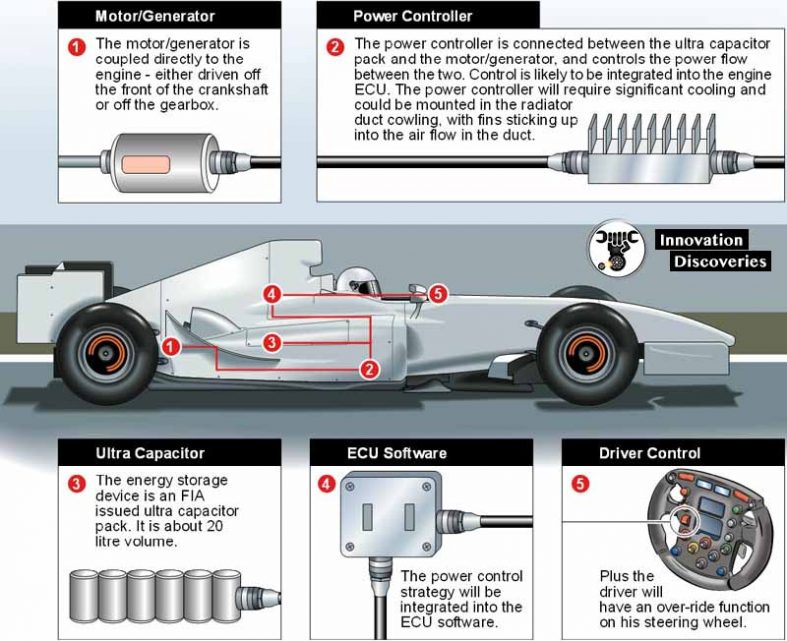Kinetic Energy Recovery System (KERS) is commonly used in
Formula 1 cars as a device for recovering kinetic energy in the form of
Electrical energy when brakes are applied. In addition to the 1.6-liter V6 engine which can produce 600 hp,
KERS can provide an additional 160 hp which can boost the speed of the car to
Overtake or to increase the lead from the other cars.
Why is KERS required?
The introduction of the new KERS system has significantly reduced the size of the Formula 1 engines from 2.4 liter V8 to 1.6 liter V6. This has resulted in higher efficiency and reduced fuel consumption by approximately 35%.
FIA allowed the use of KERS in Formula 1 cars for the first time in 2009.
At that time, the system could only produce 80 BHP
And was also not mandatory for the teams to install in their cars due to space and weight constriction.
However in 2014,
All companies agreed to install the new KERS which could generate 160 BHP
And also to balance the shift from 2.4 liter V8 to 1.6-liter V6 engine.
Working of KERS:
The KERS introduced in 2009 was used to draw energy from
Rear-axle of the car and could store 400 KJ of energy per lap,
Which can be reused in the form of a boost to add 80 bhp to the wheels. The energy is recovered during braking and is reused as a boost for 6.6 seconds per lap. The recovered energy can be stored electrically,
In a battery or a supercapacitor or mechanically, in a flywheel.
The energy can be recovered by the driver by using a ‘Boost button’ on the steering wheel.
The new system introduced in 2014 allowed the system to recover energy from,
All four wheels and also from the exhaust gas. It consists of two separate Motor Generator Units (MGUs). The MGUs in the form of generator generates electricity and,
It can also function as a motor generating mechanical energy.
MGU-K (where ‘K’ stands for kinetic energy),
Can convert the kinetic energy generated during braking into electrical energy and
Store it in the supercapacitor. It also acts as a motor to power the drivetrain by returning approximately 160 hp. This unit can recover a maximum of 2 MJ of energy.
MGU-H (where ‘H’ stands for heat energy)
It can convert the heat energy from the exhaust into electrical energy. This unit is
Connected to the turbocharger and also controls the speed of the turbocharger.
The energy recovered by this unit is used to power the MGU-K unit and
Further, transmitted to the drivetrain. The maximum amount of energy that can be recovered by both the MGUs is 4 MJ,
Which is 10 times higher than the 2009 model.
The driver can use an additional boost of 160 hp from KERS for 33 seconds per lap.

The power unit consists of 6 components:
- Internal combustion engine
- Motor Generator Unit (MGU-K)
- Motor Generator Unit (MGU-H)
- Energy Store ( Supercapacitor)
- Turbocharger
- Control Electronics
The teams are allowed to use only 5 of the 6 power units,
During the entire championship season. If they use all 6, a grid penalty will be imposed on the driver.
Don’t miss
IC ENGINE: COMPONENTS AND THEIR FUNCTIONS, TYPES, AND TERMINOLOGY
TURBOCHARGER: COMPONENTS, WORKING PRINCIPLES, AND TYPES



2 Comments